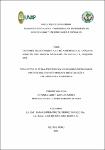Factores relacionados a la no adherencia al targa en adultos con VIH/SIDA atendidos en IPRESS I- 4, Requena2019

Date
2023Author
Garcia Ramirez, Veronica Janet
Lomas Labajos de Vela, Mercedes Isabel
Metadata
Show full item recordAbstract
The objective of the research was to determine the relationship between sociodemographic factors: age, sex, time of illness, level of education and origin; and non-adherence to ART in adults with HIV/AIDS who attend the Health Services Provider Institution I-4 Requena, in 2019. Methodology: the observational method was used, the type of design was descriptive, correlational and retrospective. The study population consisted of 84 patients. The instrument used was the questionnaire, made up of two sections, in the first section 5 items related to sociodemographic factors were considered and the second section consisted of 11 items related to nonadherence. The time required for its application was 10 minutes, it had a validity of 96.9% and a reliability of 0.811. The results indicate that of 84 patients, 97.6% (82) patients presented low non-adherence to treatment, 69.0% (58) were young adults. Likewise, 97.6% (82) patients presented low non-adherence to treatment, 84.5% (71) had more than 1 year of the disease. To establish a relationship, the statistical test of the Contingency Coefficient was used...indicating that there is a statistically significant relationship with the level of education with CC =0.261 and p=0.046, there being no relationship with age with CC=0.098 and p=0.845; sex CC=0.195 and p=0.068; ART time CC=0.067 Y P=0.829 and origin CC=0.087 and p=0.424. The study concludes that the higher degree of instruction the study subject has, the lower the degree of non-adherence. El objetivo fue determinar la relación entre los factores sociodemográficos: edad, sexo, tiempo de enfermedad, grado de instrucción, procedencia y no adhesión al TAR en adultos con VIH/SIDA que asisten a la Institución Prestadora de Servicios de Salud I-4 Requena, en el año 2019. Metodología: se utilizó el método observacional, diseño descriptivo, correlacional retrospectivo. La población de estudio estuvo conformada por 84 pacientes. El instrumento fue un cuestionario, en el primer apartado se consideró 5 ítems relacionados con los factores sociodemográficos y el segundo apartado, estuvo conformado por 11 items relacionados con la no adherencia. El tiempo que requirió para su aplicación fue de 10 minutos, tuvo una validez de 96,9% y una confiabilidad de 0,811. Los resultados indican que, de 84 pacientes que participaron en el estudio, el 97,6% (82) presentaron baja no adherencia al tratamiento, 69,0% (58) eran adultos jóvenes. Así mismo el 97,6% (82) pacientes presentaron baja no adherencia al tratamiento, 84,5% (71) tenían más de 1 año de la enfermedad. Para establecer relación, se empleó la prueba estadística del Coeficiente de Contingencia del chi Cuadrado indicando que existe relación estadísticamente significativa con el grado de instrucción con CC =0,261 y p=0,046 no existiendo relación con edad con un CC=0,098, p=0,845; sexo CC=0,195, p=0,068; tiempo de TAR CC=0,067, p=0,829 y procedencia CC=0,087, p=0,424. El estudio concluye cuanto mayor grado de instrucción posee el sujeto de estudio, menor es el grado de no adherencia.
Collections
- Tesis [8]

